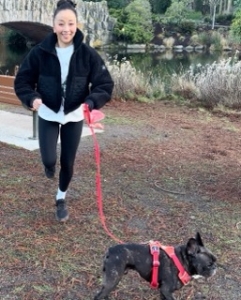Jump Training for Balance, Strength and Cardio
Overview
Jump training builds leg strength, balance, and cardio fitness while engaging the quads, glutes, hamstrings, calves, and core for better stability and power. 
Level
Beginner to Advanced
Targets
Balance, strength and cardio
Step by Step Instructions
Basic Jumping (Beginner)
- Stand with your feet hip-width apart.
- Keep your knees slightly bent and your core engaged.
- Jump straight up and down in place.
- Land softly with your knees bent, keeping them parallel (avoid letting them buckle inward or outward).
- Repeat for 10–20 jumps.
Side-to-Side Jumps (Lateral Stability)
- Stand with feet hip-width apart.
- Jump gently to the right, then to the left, keeping your knees and hips facing forward.
- Land softly after each jump.
- Repeat for 10–20 jumps per side.
Forward-and-Backward Jumps (Explosive Power)
- Stand with feet hip-width apart.
- Jump forward a few inches, then backward to the starting spot.
- Keep your knees soft and aligned with your toes.
- Repeat for 10–15 forward-and-back jumps.
Single-Leg Jump Training (Advanced)
- Stand on one leg with a slight bend in the knee.
- Jump straight up and down, landing softly on the same leg.
- Once comfortable, progress to side-to-side jumps and forward-and-back jumps on one leg.
- Repeat 5–10 times per leg.
Tips
- Form first: Keep knees parallel and soft — imagine laser beams on your knees keeping them straight.
- Land softly: Absorb the impact with your knees, hips, and ankles to protect your joints.
- Start slow: Begin with fewer jumps and gradually build volume as your strength and balance improve.
- Use arms: Swing your arms naturally to help with balance and rhythm.
Recommended Frequency
Perform this routine 2–3 times per week for improved balance, leg strength, stability, and cardiovascular conditioning.
[Video Transcript]
When’s the last time you jumped? Many people stop jumping after the age of 30, but adding jump training back into your routine can be very beneficial. Jump training is great for improving balance, building strength, and getting cardiovascular exercise — depending on how many times you jump.
Start by simply jumping up and down in place. If this feels too easy, work on your lateral stability by jumping side to side. You can also focus on front-to-back mobility by jumping forward and backward to build explosive power.
Be careful with your knees while jumping. Keep them parallel — just like you would when doing a squat or sitting in a chair. Avoid letting your knees buckle in or out. Imagine there are laser beams on your knees to help keep them aligned as you jump.
If you find basic jump training easy, try progressing to single-leg jumps. Jump on one leg at a time, either up and down, side to side, or front to back. This will challenge your balance even more and give you a greater workout.
Jump training is excellent for leg strength, balance, stability, and cardiovascular health. Try adding it to your routine and feel the difference!
Back to All Home Exercises
Download our Full Guide on Stretches and Exercises
If you’re looking for a chiropractor in Victoria, look no further than Mind Body Spine chiropractic clinic near uptown.

